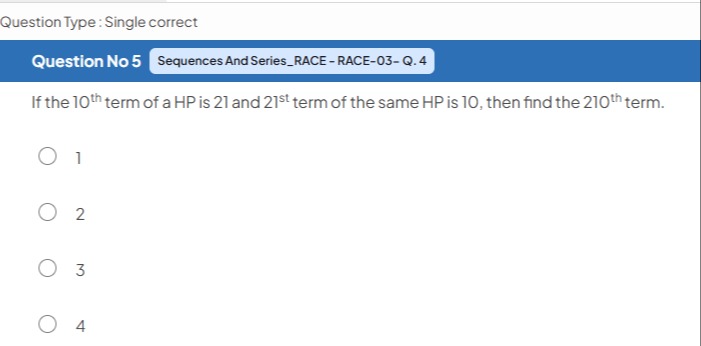Question
Question: If the $10^{th}$ term of a HP is 21 and $21^{st}$ term of the same HP is 10, then find the $210^{th}...
If the 10th term of a HP is 21 and 21st term of the same HP is 10, then find the 210th term.

1
2
3
4
1
Solution
To find the 210th term of a Harmonic Progression (HP), we first convert the problem into an Arithmetic Progression (AP) problem.
1. Relation between HP and AP:
A sequence h1,h2,h3,… is in HP if its reciprocals, h11,h21,h31,…, form an Arithmetic Progression (AP).
Let the given HP be hn and the corresponding AP be an, such that an=hn1.
The general term of an AP is given by an=A+(n−1)D, where A is the first term and D is the common difference.
2. Formulate equations for the corresponding AP terms:
Given:
10th term of HP (h10) is 21.
So, the 10th term of the corresponding AP (a10) is 211.
Using the AP formula:
a10=A+(10−1)D=A+9D=211 (Equation 1)
21st term of HP (h21) is 10.
So, the 21st term of the corresponding AP (a21) is 101.
Using the AP formula:
a21=A+(21−1)D=A+20D=101 (Equation 2)
3. Solve the system of equations to find A and D:
Subtract Equation 1 from Equation 2:
(A+20D)−(A+9D)=101−211
11D=21021−10
11D=21011
D=2101
Substitute the value of D into Equation 1:
A+9(2101)=211
A+2109=211
A+703=211
A=211−703
To subtract, find the Least Common Multiple (LCM) of 21 and 70, which is 210.
A=21×101×10−70×33×3
A=21010−2109
A=2101
So, for the corresponding AP, the first term A=2101 and the common difference D=2101.
4. Calculate the required term of the AP:
We need to find the 210th term of the HP, which means we first find the 210th term of the corresponding AP (a210).
a210=A+(210−1)D
a210=A+209D
Substitute the values of A and D:
a210=2101+209(2101)
a210=2101+209
a210=210210
a210=1
5. Convert back to the HP term:
The 210th term of the HP (h210) is the reciprocal of the 210th term of the AP (a210).
h210=a2101
h210=11
h210=1
The 210th term of the HP is 1.
